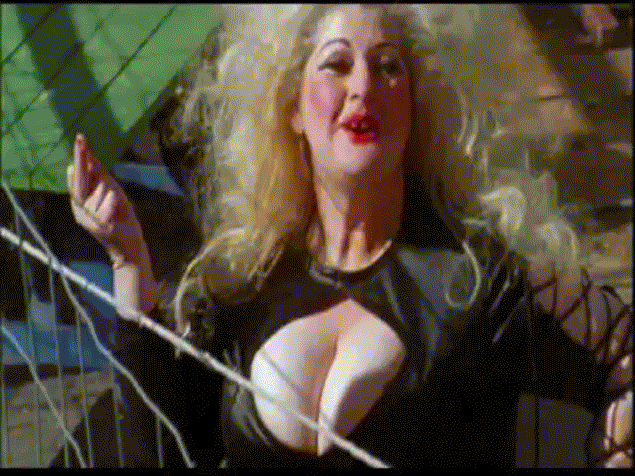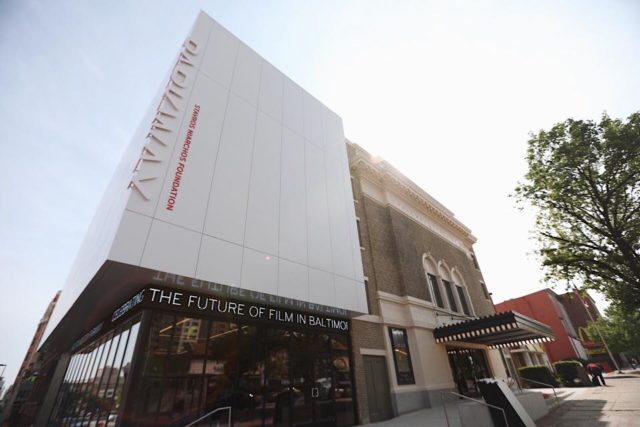
I’m looking up at Divine’s face, projected to nearly the size of a house, cackling maniacally as she hurls a dead fish at a sauntering catsuit-clad Edith Massey. I’ve watched this scene more times than I can count, but for the first time in my life, hundreds of other people are laughing along too. That’s part of the magic of cinema as a collective experience—if John Waters is “The Pope of Trash”, his sermon of degeneracy deserves its own basilica.
And finally, Baltimore filmmakers have just that. Waters himself was there to inaugurate The Maryland Film Festival’s new permanent home in the old Parkway Theater, a palatial ruin preserved (in its own state of degeneracy, appropriately) with a light-handed renovation. The theater opened its doors for regular screenings the night of May 12th with Waters’ 1974 masterpiece Female Trouble. Film historian Chris Holmlund (who literally wrote the book on Female Trouble) introduced the director and the cult classic, praising it as “A high point in low taste… this is Waters’ Citizen Kane.”
And while the film is truly glorious in its outrageousness (many attribute Van Smith’s costumes and makeup as one of the major influences of punk fashion) it was, for me, not the evening’s main attraction. Just being inside the theater itself was revelatory. The Parkway had been shuttered for decades—it had last been used as an arthouse theater in 1978, the heydey of the Dreamlanders, and its lobby was home to a Korean grocery store in the 1980s—looming over my old neighborhood like a grand mausoleum. It’s restoration hasn’t been without controversy, but the upside of that discussion has been under-known histories getting dusted off and brought to light. The Parkway opened in 1915, at a time when cinema was relatively new art form. The main theater’s idiosyncrasies are evidence to that inexperience—the dimensions of the stage and peculiar seating arrangements such as private balconies to the side are more suited to live theater. In the 1990s, the short-lived organization Heritage Shadows of a Silver Screen unsuccessfully attempted to reopen The Parkway as a center dedicated to African-American filmmaking. Apparently Harry Belafonte’s handprints graced the sidewalk outside as a result of that endeavor, until they were destroyed in a failed restoration attempt during the building’s latest renovation. Despite living just blocks away from the Parkway since the age of 17, I hadn’t known any of this until recently.
And, of course, I had my own mixed feelings about the project—despite being an avid fan of the Maryland Film Festival. The Stavros Niarchos Foundation Parkway Film Center (as the theater is officially, but not colloquially, known) comprises more than just the old theater itself. Its footprint extends to several buildings on the corner of Charles Street, all of which were city-owned and awarded to the MFF. Included among these was a formerly beloved late-night takeout spot that was, according to rumor, shuttered by the city in a previous sketchy failed gentrification scheme involving an upscale steakhouse. That building has been demolished, replaced by a mostly-windowless silver cube clad in those types of metal panels that make even the best-rendered architectural plans look cheap when realized. Next door, an old brick building I had always thought would make great live/work lofts has been gutted to house (what looks to be exclusively) a staircase and elevator shaft for the theater. It felt like a waste of historic architecture considering eminent domain was involved in assembling the parcels (to be fair, well before the MFF was) and the other side of the Parkway faces nothing but a McDonald’s parking lot. God forbid the city should ever seize that!
These losses wouldn’t sting so hard were they not the latest (albeit least nefarious) in a local trend I like to call “institutional creep”. In a poor city with well-endowed universities, hospitals, and other institutions, all-too-many historic traces of vernacular city life are often swept away by the powerful to create student centers, parking garages, prayer gardens (!?), or even entire new neighborhood-displacing districts. The tragedy of The Parkway’s immediate environs, for example, is that the dream of becoming an “arts district” will never be realized to its full potential. Property owners land bank buildings in the hopes a nearby institution or city redevelopment initiative will pay a premium to assemble large lots. In the meantime, buildings rot beyond the point of reasonable repair while artists must look elsewhere for affordable real estate—despite all the tax incentives supposedly designed to have kept us there.
So Parkway or not, that brick building was never likely to end up as affordable lofts. Obviously I don’t resent The Maryland Film Festival for these larger problems—I’m glad they’re the ones benefiting from late capitalism’s strange cycles of waste. At heart, the organization feels like an artist-run initiative that will now be able to weather the gentrification wave in stride (it had previously operated out of another nearby art house cinema and various other, more precarious venues in its vicinity). Their mission statement is “Film for Everyone”, and that shows. Numerous out-of-town directors have told me the MFF is their favorite annual event precisely because it’s affordable and accessible to normal people—not just industry insiders. At their new home, they’ll continue to bring local, international, overlooked, limited release, or vintage films to the public for a cheaper admission than most suburban multiplexes. Now, all year round.
And stepping into the space (tastefully restored by Ziger/Snead architects), that questionable exterior cladding (seriously, it looks like a Borg cube on a budget) can be forgiven. The architects opted to only restore what had to be replaced (the lobby’s ceiling, for example). Everything else is either unapologetically new or left in its state of glorious decay. Personally, I appreciate this approach to theater restoration more than the nostalgic style popularized by the late architect Hugh Hardy. If the guiding motivation behind that approach was to make Broadway theater-goers forget that the gilded cinema palaces of 42nd Street spent much of the 20th century screening cheap porn, the spirit here is one of not forgetting the area’s recent past. In a city with near-perpetual, seemingly deliberate spatial amnesia with regards to the post-war built environment, that’s refreshing. Without the “blight” of the past 50-something years, there likely never would have been a space for culture like Female Trouble to flourish (Dawn Davenport’s stylized home was a set built illegally in a condemned apartment). My only qualm with the interiors is an abrasive blue carpet in the main theater. That’s easily overlooked when the lights go down.
Even the hypercube has its logic. The bottom floor is generously transparent to the busy corner, housing a bar/coffee shop. Above, two smaller black-box theaters each seat 85 for films that might not draw a large enough audience to fill the cavernous historic venue. What wonders will these hold? If this month’s calendar is any indication, treats far less mundane than 3 a.m. chicken box and lake trout. And hell, anything christened by John Waters is A-OK in my book.




Comments on this entry are closed.
{ 1 trackback }